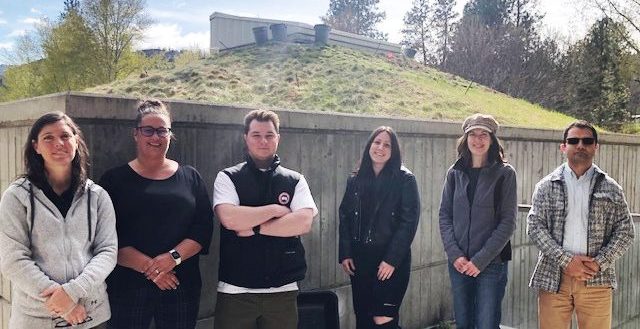
Building a sustainable university – TRU Newsroom
Innovate Today for a Better Tomorrow project team in front of the HL green roof. From left to right: Amie Schellenberg, Crystal Schock, Corbin Guenther, Amaia Zearra, Sandra Jasinoski, and Hossein Banitabaei. Missing from the photo are Dale Parkes and Warren Asuchak.
KAMLOOPS – Every day is Earth Day at Thompson Rivers University (TRU). The Kamloops campus is teeming with initiatives showcasing the university’s dedication and commitment to expanding its established leadership in environmental sustainability.
By implementing green technology, TRU is helping reduce the environmental impact of its buildings and create a more sustainable community. This all sounds great, but what does it actually look like on campus right now? Here are three examples of how TRU is going greener than ever this Earth Day.
More than a pledge: Carbon neutral by 2030
Fossil-fuel free by 2030: Low-Carbon District Energy systems (LCDES)
TRU has partnered with Creative Energy to build one of the most advanced Low-Carbon District Energy systems (LCDES) in the world — right in the heart of the Kamloops campus. The LCDES project is part of TRU’s Community Climate Action Plan and considers TRU’s ongoing commitment and pledge to becoming a carbon-neutral campus or fossil-fuel free by 2030.
TRU’s greatest source of greenhouse gas emissions is natural gas used for heating. The new system will reduce greenhouse gas emissions from all campus buildings by 95 per cent, according to Creative Energy. That’s equivalent to planting a 4,000-acre forest — about 16 times bigger than campus.
The LCDES will empower TRU’s shift toward renewable heating and set the stage with renewable infrastructure for future growth.
Construction is expected to begin by fall 2024 and the goal is for the LCDES to connect most major campus buildings by 2030.
Learn more: Low Carbon Development: Community Climate Action Plan
A cooler future
Kamloops experiences extreme temperatures in summer and winter. This creates unique challenges regarding the energy efficiency of campus buildings and comfort levels of people who study, work, play and live on campus.
With record-breaking heat-related events like heat domes and atmospheric rivers becoming more frequent, TRU’s faculty, staff and students are joining with industry and community partners to find the most appropriate solutions for two campus buildings: the Early Childhood Education Centre (ECEC) and the Brown Family House of Learning (HL) green roof.
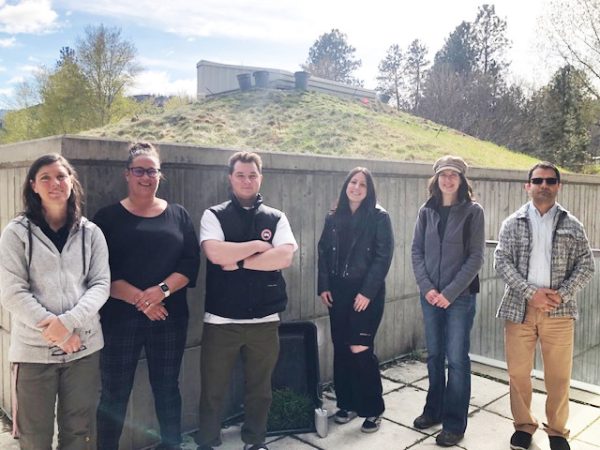
Innovate Today for a Better Tomorrow project team in front of the HL green roof. From left to right: Amie Schellenberg, Crystal Schock, Corbin Guenther, Amaia Zearra, Sandra Jasinoski, and Hossein Banitabaei. Missing from the photo are Dale Parkes and Warren Asuchak.
“In a time when we are facing an unprecedented heat-related climate crisis, we must think outside the box and work together to help mitigate the effects of climate change and adapt to our new normal,” says Dr. Sandra Jasinoski, project manager and research associate in the Faculty of Science.
The project, known as Innovate Today for a Better Tomorrow: Improving TRU campus buildings with green technology to showcase options for a more sustainable future, is supported by a TRU Sustainability Grant fund. This project involves students, staff and faculty working together with industry and community partners to find the most appropriate green technology solution.
Innovate Today for a Better Tomorrow addresses many of the goals and themes in TRU’s Campus Strategic Sustainability Plan, including providing research opportunities for students and highlighting the green technology to the campus community and the larger citizenship of Kamloops.
Student-suggested window film
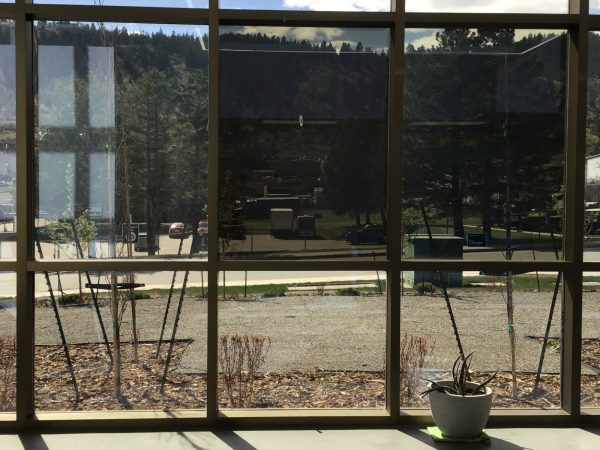
Inside the ECEC building, two window film samples (top right) demonstrate light reflection.
The first thing visitors walking into the Early Childhood Education Centre notice is a large sitting area with floor-to-ceiling windows that face south-southwest. Called a curtain wall, this floor-to-ceiling bank of windows greatly increases the interior temperatures during the summer months — so much so that air conditioning can’t sufficiently cool the space. The curtain wall also creates construction constraints: nothing can be drilled into or attached to it.
Zearra says as an institution committed to sustainability, TRU must prioritize improving the existing infrastructure, which involves identifying buildings such as the ECEC and implementing solutions that enhance comfort and create more welcoming spaces.
The window film reflects most infrared heat and UV light, while still allowing visible light to pass to through.
“This proactive approach to managing solar heat gain contributes significantly to enhancing the building’s energy efficiency and occupants’ comfort,” says Dr. Hossein Banitabaei, project faculty advisor and assistant teaching professor in architectural and engineering technology.
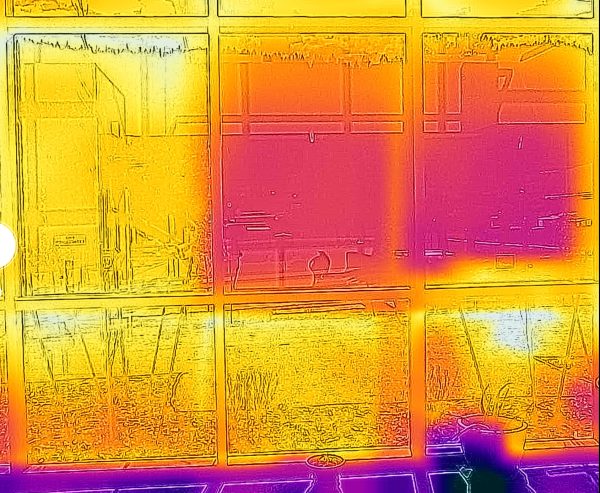
Thermal image of window film samples, taken from inside ECEC, illustrates the film’s ability to reduce the amount of solar heat entering the building.
This solution addresses overheating issues and make temperatures more comfortable for occupants. How much more enjoyable? Dr. Banitabaei says simulations have demonstrated the window film could reduce solar heat intake in the ECEC building by up to 65 per cent.
“By showcasing these green technologies on campus, community members will be able to witness firsthand the tangible benefits of sustainable solutions,” he says.
A sample of window film was installed in late September 2023. Full installation is being done during Earth Day week. And the team is already looking at installing this film on other TRU buildings.
Old dirt, new life
Spring weather brings plants back to their green glory, and one place where that is freshly apparent is atop the Brown Family House of Learning, where the same Innovate Today for a Better Tomorrow team is working to revitalize the green roof.
“We need to ensure that the green roof components and the plants can withstand these new climate-related conditions including prolonged drought,” says Jasinoski. The HL’s green roof was originally built in 2010 and planted in spring of 2011, featuring three types of grasses not native to this region: Karl Foerster (ornamental feather reed grass), blue fescue and blue oat grass.
The roof has been neglected in recent years, and is now being restored through revitalization and adaptation. Revitalization includes checking components of the green roof and fixing any deficiencies. Adaptation ensures the roof can withstand heat-related climate events and ongoing drought.
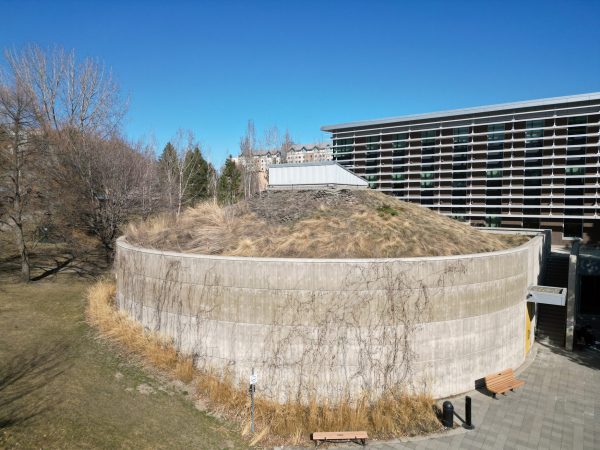
Green roof benefits include reducing energy consumption, increasing native pollinators, and improving air quality (GSA, 2011)
“Visual analysis of the green roof indicated significant areas where vegetation was either dead, struggling to survive or being invaded by other species that had not been part of the initial planting scheme,” says Crystal Schock, project co-ordinator and co-ordinator in Space, Planning and Design.
“The opportunity to revitalize the roof with new vegetation that is better aligned with current climate trends presented itself, and our team was extremely fortunate to have the support of the TRU Sustainability Grant to help accomplish this,” she says.
“Sustainability is one of TRU’s values: As a world leader in sustainability, we know that the well-being of generations to come is shaped by what we do today. Our work on the green roof today can help inform high-performance building decisions tomorrow,” says Amie Schellenberg, chair of the School of Trades and Technology and associate electrical instructor, who is involved in the project.
“It also supports TRU’s 10-year change goals by leading in community research and scholarship as well as promoting lifelong learning,” she says.
“By using native plant species, we acknowledge and give honor to the Secwépemc ancestral peoples who have lived harmoniously on this land for thousands of years.”
Corbin Guenther, architectural and engineering technology student research assistant, says HL’s green roof promotes sustainability and a healthy urban ecosystem using biodiverse native plant species, local landscaping and rainwater management. “It is a testament to what can be used in Kamloops to aid in the fight against climate change.”
Connected through climate
These projects together embody change on campus and within the community. Jasinoski says the team hopes results of the Innovate Today for a Better Tomorrow project inspire others to adopt environmentally conscious measures within their own workplaces, homes and recreational spaces. “This will further contribute to making our society more sustainable as well as adapting to the future challenges of a warming planet,” says Jasinoski.
